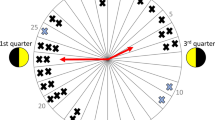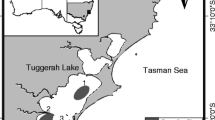Abstract
The annual epidemic spawning period of a Scottish population of Arenicola marina (L.) has been recorded over a period of 13 yr. This population spawns between mid-October and mid-November in a discrete spawning event over a period of 4 to 5 d. Endocrine manipulation experiments showed that spawning is induced in females only if sufficient titres of PMH (prostomial maturation hormone) are present in the prostomia. These levels are attained during the 2 to 3 wk prior to the natural spawning date. The East Sands, St. Andrews population always spawns during periods of spring tides regardless of tidal amplitude or whether they are full- or new-moon tides. Meteorological data, including sea-temperature data were collected for each year, and correlation of the environmental data with spawning time was attempted. Correlation of spawning times with weather patterns showed that mean daily air pressures were significantly higher during the spawning period than from September to November as a whole. Evidence also suggests that a reduction in sea temperature is required prior to spawning. A significant moderate negative correlation was found between May to July air temperatures and spawning date, suggesting that higher May to July temperatures may induce early spawning. Daily rainfall and wind speed were also lower during the spawning period, but not significantly so. These results indicate that air pressure (or changes therein) may act as a final spawning cue, and the advantages of this are discussed in relation to fertilization success. A model of the interplay between environmental parameters and the endocrine mechanisms controlling the induction of spawning is proposed. Higher than average summer temperatures may advance gametogenesis to bring the population into a state of maturity (full-size oocytes, well-developed sperm morulae), and may also advance spawning time. Once the population has completed gametogenesis, a drop in sea temperature is then required to trigger an increase in endocrine titres within the prostomium, without which spawning cannot be induced by prostomial injection. The population spawns on spring tides; however a lack of clement weather coinciding with the spring tide will result in population-wide spawning being aborted, as in 1996. Clement weather (high pressure, low rainfall and wind speed) in conjunction with spring tides permits spawning to proceed to completion.
Similar content being viewed by others
Author information
Authors and Affiliations
Additional information
Received: 21 June 1999 / Accepted: 25 January 2000
Rights and permissions
About this article
Cite this article
Watson, G., Williams, M. & Bentley, M. Can synchronous spawning be predicted from environmental parameters? A case study of the lugworm Arenicola marina. Marine Biology 136, 1003–1017 (2000). https://doi.org/10.1007/s002270000283
Issue Date:
DOI: https://doi.org/10.1007/s002270000283




